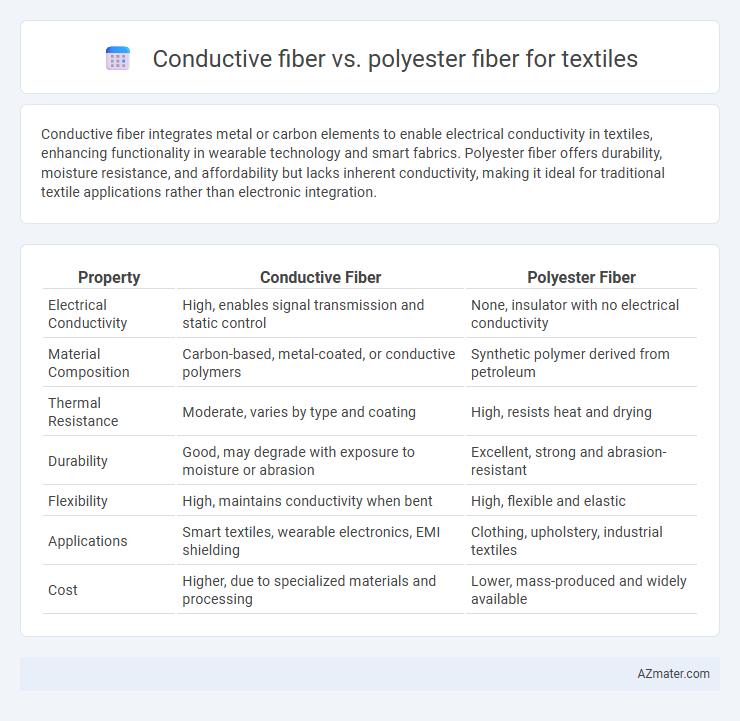Conductive fiber integrates metal or carbon elements to enable electrical conductivity in textiles, enhancing functionality in wearable technology and smart fabrics. Polyester fiber offers durability, moisture resistance, and affordability but lacks inherent conductivity, making it ideal for traditional textile applications rather than electronic integration.
Table of Comparison
| Property | Conductive Fiber | Polyester Fiber |
|---|---|---|
| Electrical Conductivity | High, enables signal transmission and static control | None, insulator with no electrical conductivity |
| Material Composition | Carbon-based, metal-coated, or conductive polymers | Synthetic polymer derived from petroleum |
| Thermal Resistance | Moderate, varies by type and coating | High, resists heat and drying |
| Durability | Good, may degrade with exposure to moisture or abrasion | Excellent, strong and abrasion-resistant |
| Flexibility | High, maintains conductivity when bent | High, flexible and elastic |
| Applications | Smart textiles, wearable electronics, EMI shielding | Clothing, upholstery, industrial textiles |
| Cost | Higher, due to specialized materials and processing | Lower, mass-produced and widely available |
Introduction to Conductive Fiber and Polyester Fiber
Conductive fiber, composed of materials like carbon nanotubes, metal-coated yarns, or conductive polymers, enables the transmission of electrical signals and thermoregulation in textiles. Polyester fiber, a synthetic polymer derived from petroleum, offers durability, wrinkle resistance, and moisture-wicking properties, making it a versatile choice in textile manufacturing. Comparing conductive fibers to polyester fibers highlights their distinct functional roles: conductivity and smart textile integration versus mechanical strength and comfort in apparel.
Key Properties of Conductive Fiber
Conductive fibers exhibit excellent electrical conductivity, making them ideal for smart textiles and wearable electronics, whereas polyester fibers primarily offer durability, moisture resistance, and elasticity. Key properties of conductive fibers include low electrical resistance, flexibility, lightweight nature, and compatibility with various textile manufacturing processes. These fibers often incorporate materials like silver, copper, or carbon nanotubes to enhance conductivity while maintaining breathability and comfort.
Key Properties of Polyester Fiber
Polyester fiber offers high durability, excellent wrinkle resistance, and superior moisture-wicking properties, making it a preferred choice for textile applications requiring longevity and comfort. Its hydrophobic nature ensures quick drying and resistance to shrinking or stretching, enhancing garment performance during wear. Compared to conductive fibers, polyester fibers provide greater tensile strength and cost efficiency, although they lack intrinsic electrical conductivity used in smart textiles.
Electrical Conductivity Comparison
Conductive fibers, typically made from materials such as silver, copper, or carbon-based compounds, exhibit significantly higher electrical conductivity compared to polyester fibers, which are primarily insulating and lack intrinsic conductive properties. Polyester fibers require coating or embedding with conductive materials to achieve any level of electrical conductivity, but even then, their conductivity remains substantially lower than that of pure conductive fibers. This contrast makes conductive fibers ideal for applications like smart textiles and wearable electronics, where efficient electrical signal transmission is crucial.
Mechanical Strength and Durability
Conductive fibers exhibit superior mechanical strength compared to polyester fibers, benefiting applications requiring high tensile resilience and flexibility. Polyester fibers offer excellent durability with strong resistance to abrasion, chemicals, and environmental factors, making them ideal for textiles subject to harsh conditions. The integration of conductive fibers enhances the durability of smart textiles while maintaining the mechanical robustness typical of polyester-based fabrics.
Applications in Smart Textiles
Conductive fibers enable the integration of electrical conductivity into textiles, making them essential for wearable electronics, health monitoring, and interactive garments, whereas polyester fibers primarily provide durability, flexibility, and moisture resistance but lack inherent conductivity. Smart textiles incorporate conductive fibers for sensors, heating elements, and data transmission, while polyester often serves as a structural base or protective layer. Combining conductive fibers with polyester enhances comfort and functionality, optimizing performance in sportswear, medical devices, and military apparel.
Comfort and Wearability Factors
Conductive fiber offers superior breathability and moisture-wicking properties compared to polyester fiber, enhancing wearer comfort in active or heated environments. Polyester fiber, while durable and resistant to wrinkles and shrinking, tends to trap heat and moisture, potentially reducing overall comfort during extended wear. The integration of conductive fiber into textiles improves thermal regulation and flexibility, making it ideal for performance apparel that requires both comfort and wearability.
Cost and Scalability in Production
Conductive fibers typically have higher material and manufacturing costs compared to polyester fibers, primarily due to the integration of metal or carbon-based conductive elements. Polyester fibers benefit from well-established, large-scale production processes, resulting in lower costs and greater scalability for mass textile manufacturing. The scalability of conductive fibers is currently limited by complex production techniques and cost-intensive raw materials, making polyester more economically viable for high-volume textile applications.
Environmental Impact and Sustainability
Conductive fibers, often made from metals or carbon-based materials, typically have a higher environmental footprint due to energy-intensive production processes and challenges in recycling compared to polyester fibers. Polyester fibers, derived from petrochemicals, contribute significantly to microplastic pollution but benefit from widespread recyclability and advancements in sustainable recycling technologies. Evaluating environmental impact, polyester fibers offer scalability and improved circularity, whereas conductive fibers demand innovation in sustainable sourcing and end-of-life management to reduce ecological harm.
Future Trends in Conductive and Polyester Fibers
Conductive fibers are rapidly advancing with the integration of nanomaterials like graphene and silver nanoparticles, enhancing electrical conductivity and flexibility for smart textile applications. Polyester fibers continue to evolve through bio-based and recycled variants, supporting sustainability efforts and improving mechanical properties for performance wear. Future trends emphasize hybrid blends combining conductive and polyester fibers to create multifunctional textiles with energy harvesting, sensor integration, and environmental resistance.

Infographic: Conductive fiber vs Polyester fiber for Textile
 azmater.com
azmater.com